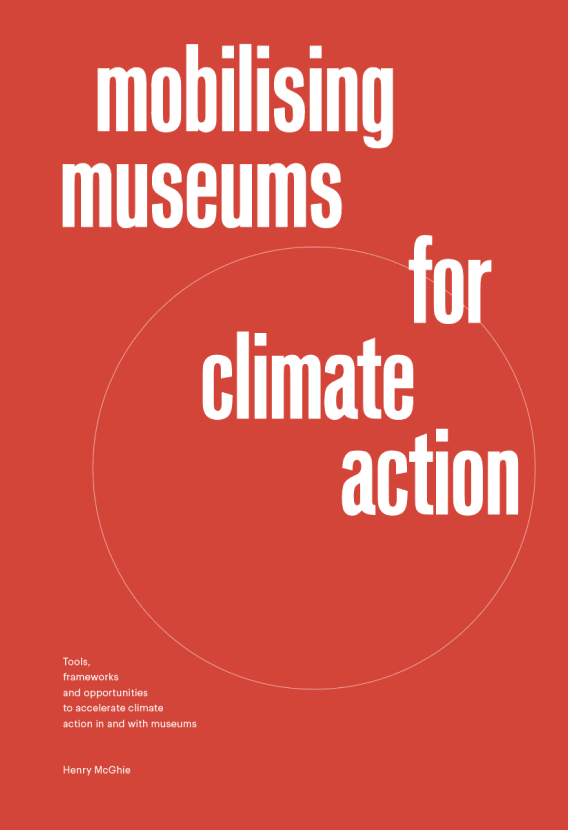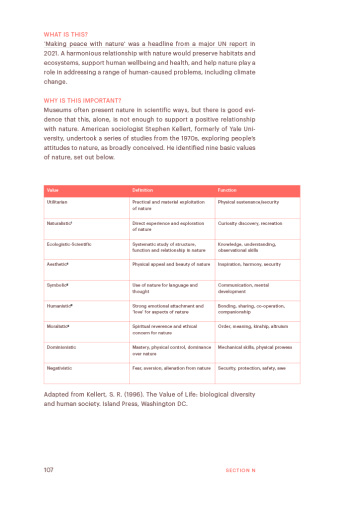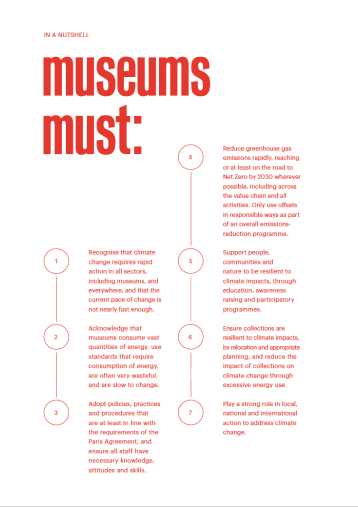Towards positive relationships with nature
( Toolbox )
WHAT IS THIS?
‘Making peace with nature’ was a headline from a major UN report in 2021. A harmonious relationship with nature would preserve habitats and ecosystems, support human wellbeing and health, and help nature play a role in addressing a range of human-caused problems, including climate change.
WHY IS THIS IMPORTANT?
Museums often present nature in scientific ways, but there is good evidence that this, alone, is not enough to support a positive relationship with nature. American sociologist Stephen Kellert, formerly of Yale University, undertook a series of studies from the 1970s, exploring people’s attitudes to nature, as broadly conceived. He identified nine basic values of nature, set out below.
| Value | Definition | Function |
|---|---|---|
| Utilitarian | Practical and material exploitation of nature | Physical sustenance/security |
| Naturalistic¹ | Direct experience and exploration of nature | Curiosity discovery, recreation |
| Ecologistic-Scientific | Systematic study of structure, function and relationship in nature | Knowledge, understanding, observational skills |
| Aesthetic² | Physical appeal and beauty of nature | Inspiration, harmony, security |
| Symbolic³ | Use of nature for language and thought | Communication, mental development |
| Humanistic⁴ | Strong emotional attachment and ‘love’ for aspects of nature | Bonding, sharing, co-operation, companionship |
| Moralistic⁵ | Spiritual reverence and ethical concern for nature | Order, meaning, kinship, altruism |
| Dominionistic | Mastery, physical control, dominance over nature | Mechanical skills, physical prowess |
| Negativistic | Fear, aversion, alienation from nature | Security, protection, safety, awe |
Adapted from Kellert, S. R. (1996). The Value of Life: biological diversity and human society. Island Press, Washington DC.
Based on large-scale, global studies, Kellert and colleagues proposed that these values are more or less universal, but their relative importance is widely different, between different countries, age groups, based on gender, and based on occupation. The strength of the approach is that it enables those working with groups of people with different values or in situations of conflict to better understand one another’s viewpoints, and so address or work through points of tension or conflict. Classic examples would be whether or not Wolves should be allowed to exist in certain areas, because of conflict between conservationists and farmers; whether nature should be preserved for its own sake or because of its usefulness to people (the ‘Amazon may hold cure for cancer’ argument); or whether jobs or the environment should be prioritised in decision-making regarding climate change.
Nature connectedness research is an applied psychology field, that aims to understand the causes and benefits of a strong connection with nature, and to develop effective interventions that can build a stronger connection with nature. Miles Richardson and colleagues at the University of Derby took Kellert’s original nine attitudes/values to nature, and explored how related activities were linked to a strong connection with nature. Attitudes, values and activities related to a strong connection to nature are referred to as ‘pathways to nature connectedness’. The five positive pathways are:
Contact – The act of engaging with nature through the senses for pleasure e.g. listening to birdsong, smelling wild flowers, watching the sunset. (see 1 in table above)
Beauty – Engagement with the aesthetic qualities of nature, e.g. appreciating natural scenery or engaging with nature through the arts. (see 2 in table above)
Meaning – Using nature or natural symbolism (e.g. language and metaphors) to represent an idea, thinking about the meaning of nature and signs of nature, e.g. the first swallow of summer. (see 3 in table above)
Emotion – An emotional bond with, and love for nature e.g. talking about, and reflecting on your feelings about nature. (see 4 in table above)
Compassion – Extending the self to include nature, leading to a moral and ethical concern for nature e.g. making ethical product choices, being concerned with animal welfare. (see 5 in table above)
An important point to note here is that the Ecologistic-Scientific value/ attitude was not found to contribute to a strong relationship with nature, although, as mentioned above, nature is often presented and interpreted in museums from these viewpoints.
Taking this work further, the following interventions have been suggested as fostering the pathways to nature connectedness:
Contact – get out and engage with nature. Use your senses to take a fresh look at trees, touch the bark, smell the pine needles, listen to the wind through the leaves.
Meaning – consider what nature means to you. What’s your favourite local tree and why? It’s good to have meaning in our lives.
Compassion – think about what you could do for nature. Why not make a home for nature?
Emotion – find happiness and wonder in nature. Note the good things in nature, the joy they can bring.
Beauty – take time to appreciate beauty in nature and try to capture it through art or in words.
WHAT DOES THIS MEAN FOR MUSEUMS?
Museums can draw on the findings of nature connectedness research to critically assess how they are promoting a strong connection with nature through their educational and awareness-raising programmes; and how they communicate the environment, climate, and people’s relationships with (and impacts on) climate and the environment. This is not to say that scientific research is not important – it is a fundamental part of understanding and communicating our world – but that efforts to foster a sustainable culture and society need to be built on more than scientific facts and evidence.
Museums can use the typology and pathways set out above to empower people to talk about how they relate to nature.
Museums can support cultural participation for all by reflecting and incorporating diverse values and attitudes to nature, and explore the values and attitudes in different social groups and cultures, as a way of exploring sustainable alternatives to Western consumerism and capitalism.
See sections on:
Action for Climate Empowerment (section k)
Education for Sustainable Development (section l)
Additional learning approaches (section m)


